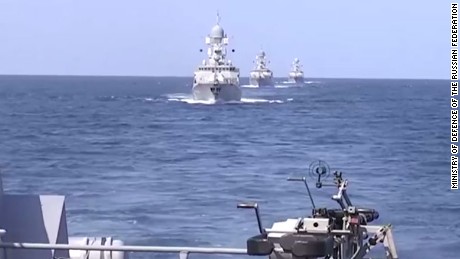
POSTED 1:56 PM, APRIL 16, 2016, BY CNN WIRE
Russia is deploying its ballistic missiles and attack submarines in numbers, range and aggression not seen in two decades, according to a top U.S. Navy official.
In an exclusive interview, the commander of U.S. Naval Forces in Europe told CNN that the buildup reflects an alarming strategic world view.
“NATO is viewed as an existential threat to Russia, and in the post-Cold War period, the expansion of NATO eastward closer to Russia and our military capability they view as a very visceral threat to Russia,” Adm. Mark Ferguson said.
Ferguson spoke from his base in Naples, Italy, home to U.S. Naval forces in Europe and the Navy’s 6th Fleet.
Adding to U.S. apprehension, Russia is deploying new submarines that are harder for U.S. naval forces to track and detect following years and billions of dollars in investment.
They are quieter, better armed and have a greater range of operation.
“The submarines that we’re seeing are much more stealthy,” Ferguson said. “We’re seeing (the Russians) have more advanced weapons systems, missile systems that can attack land at long ranges, and we also see their operating proficiency is getting better as they range farther from home waters.”
The U.S. currently has 53 submarines in its inventory, but because of decommissioning and budget decisions, Ferguson said that figure will drop to 41 by the late 2020s.
“We cannot maintain 100% awareness of Russian sub activity today,” retired Adm. James Stavridis, a former NATO supreme allied commander, told CNN. “Our attack subs are better, but not by much. Russian subs pose an existential threat to U.S. carrier groups.”
The increased Russian sub activity is backed by a much broader military expansion.
Russia is adding or upgrading some 12 naval bases across the Arctic Circle — expanding its capability to send subs in numbers through the crucial Greenland-Iceland-U.K. gap into the Atlantic — and closer to U.S. and NATO territorial waters.
They country also stationed six submarines in the Black Sea recently, giving them greater reach in the Mediterranean.
More worrying to the U.S., Moscow is also adding entirely new categories of submarines with greater capabilities to its arsenal.
“They have increased the readiness levels of the force,” Ferguson said. “They are operating it with more … out-of-area deployments, and what we are seeing is an improvement in the readiness of that force as well.”
The U.S. believes the new activity is designed to achieve multiple objectives, including denying NATO and the U.S. the ability to operate within Russia’s so-called “near abroad.”
Ferguson said that one important goal for Russia “is to build their own naval capability in the undersea domain to begin to deny NATO and the United States the ability to maneuver on the maritime flanks of NATO.”
Increasingly alarmed by Russia’s new sub developments, the U.S. and its NATO allies are launching new training exercises in anti-submarine warfare and deploying new systems, including the P8 Poseidon reconnaissance aircraft.
Russia’s growing military activity extends above the surface as well.
A Russian fighter jet’s fly-by of the USS Donald Cook this week — coming within 30 feet laterally and 100 feet vertically — is behavior U.S. naval commanders have not witnessed since the Cold War.
“We had radio calls in both English and Russian and the aircraft didn’t respond and proceeded on a course directly at the ship,” Ferguson said. “While we had seen these interactions before, this one was different because of the proximity to the ship, and the altitude and the flight path that it took.”
No comments:
Post a Comment